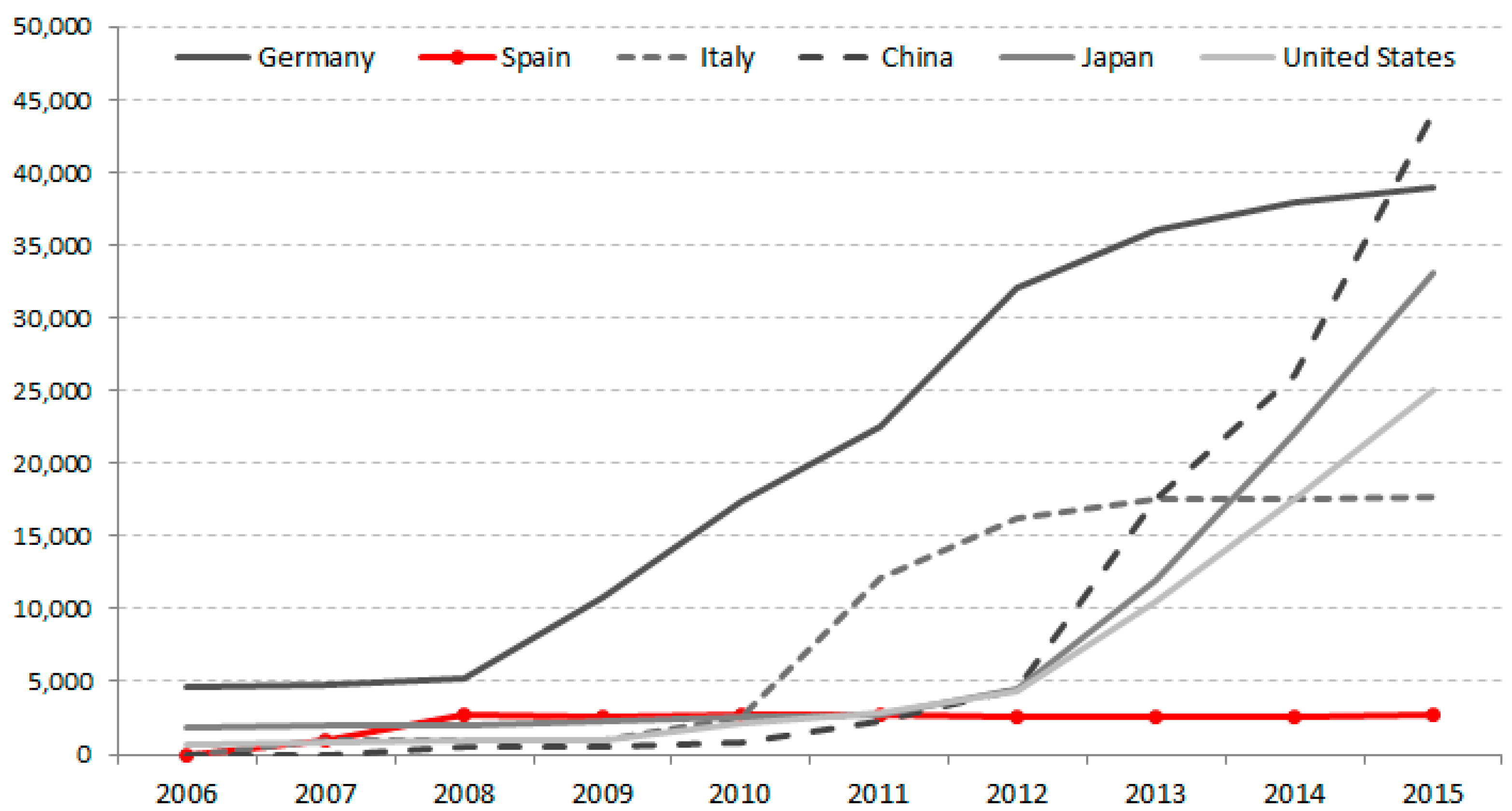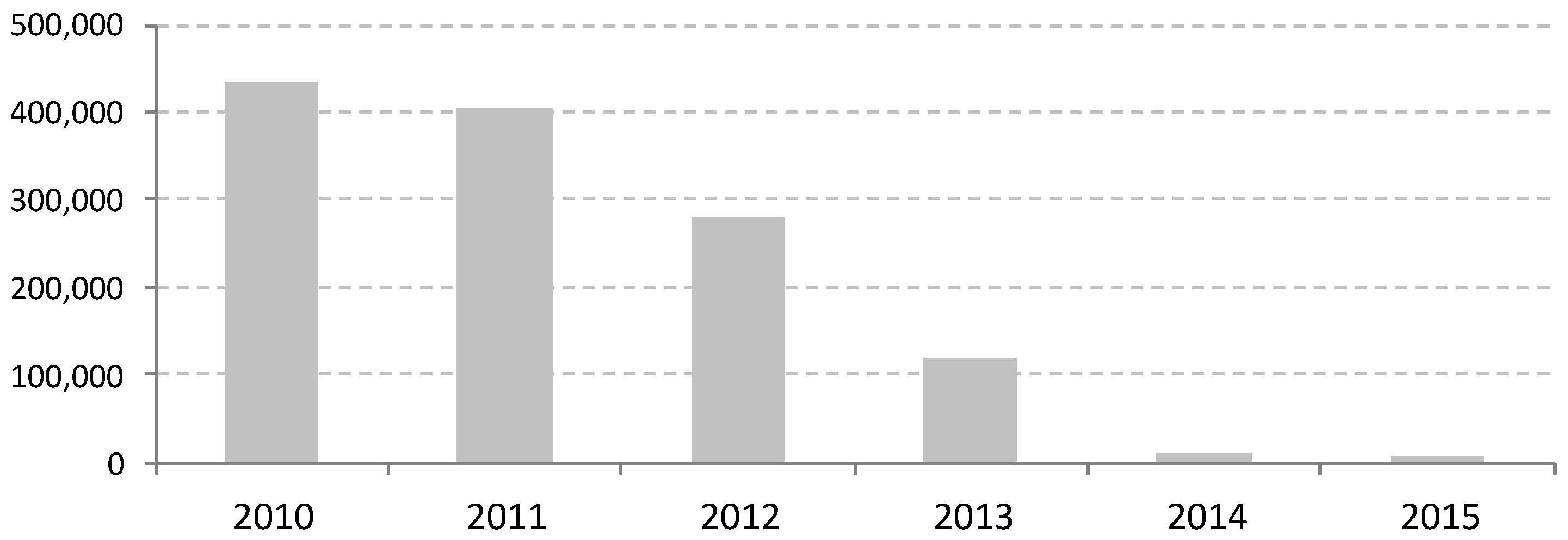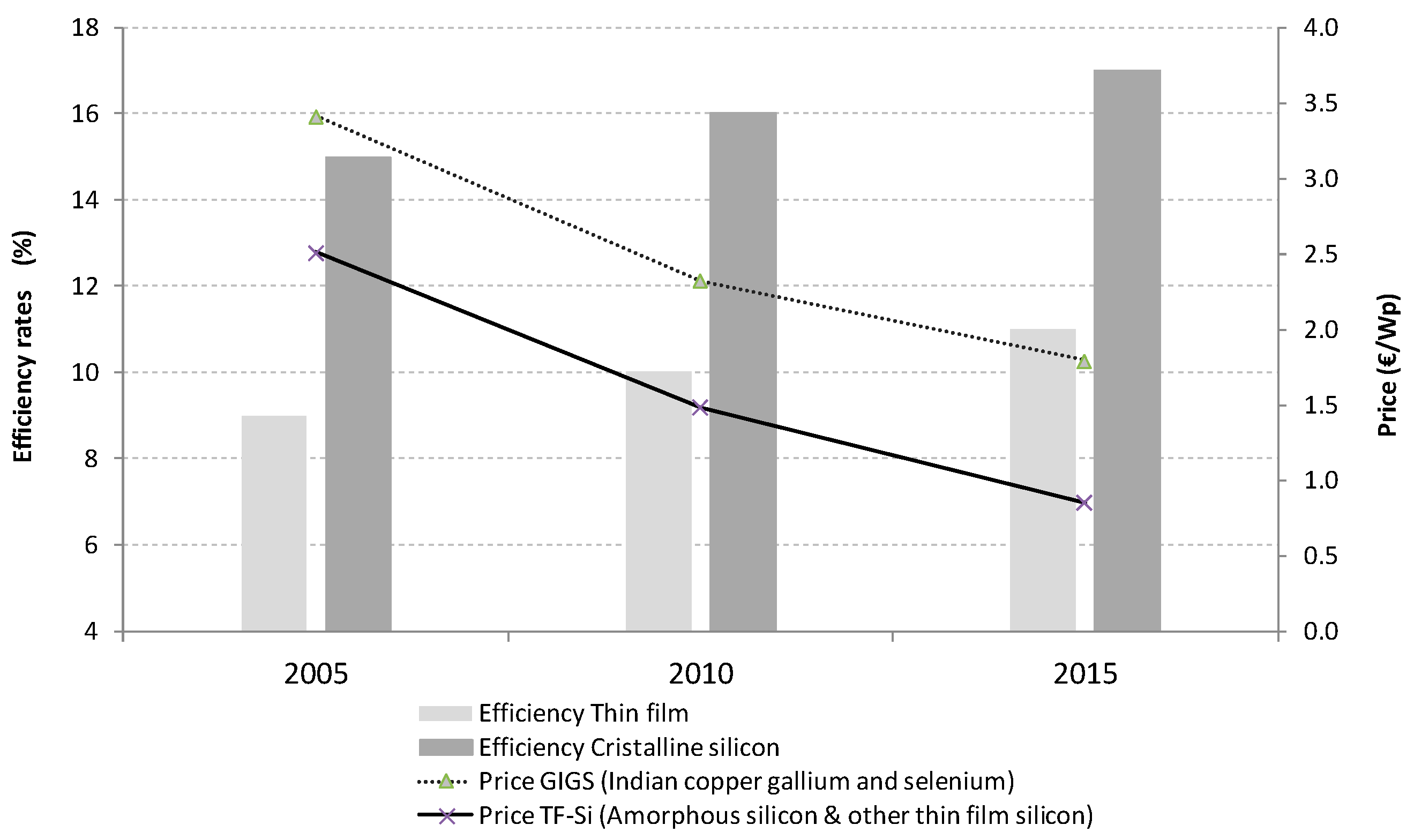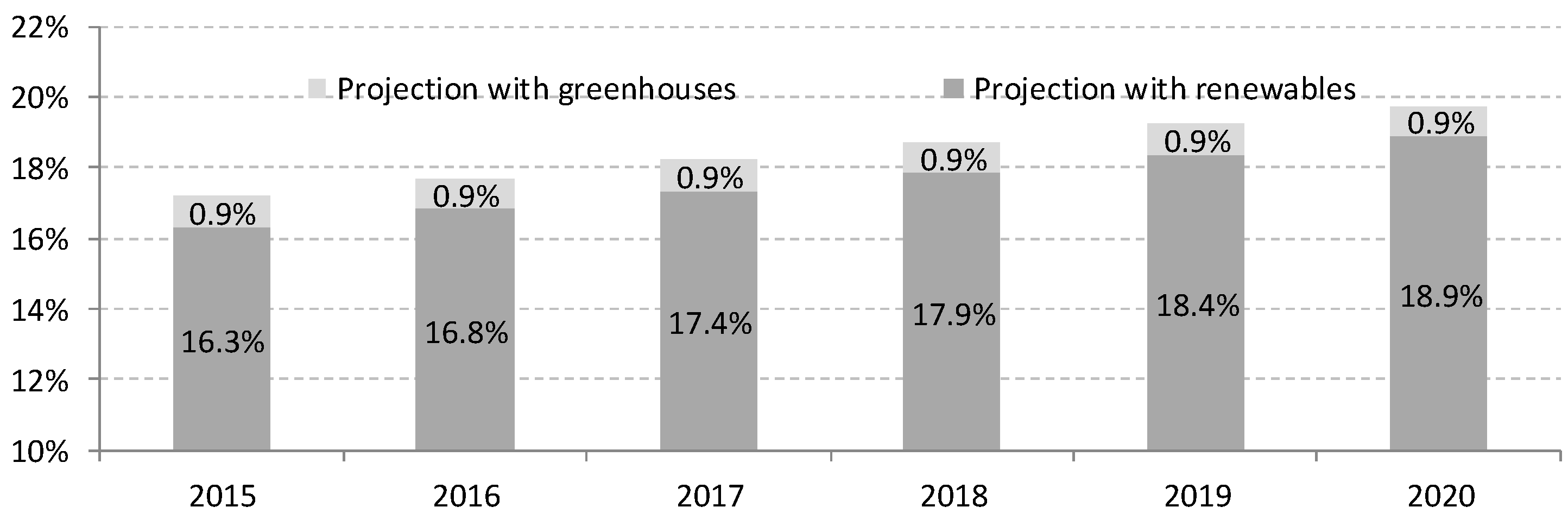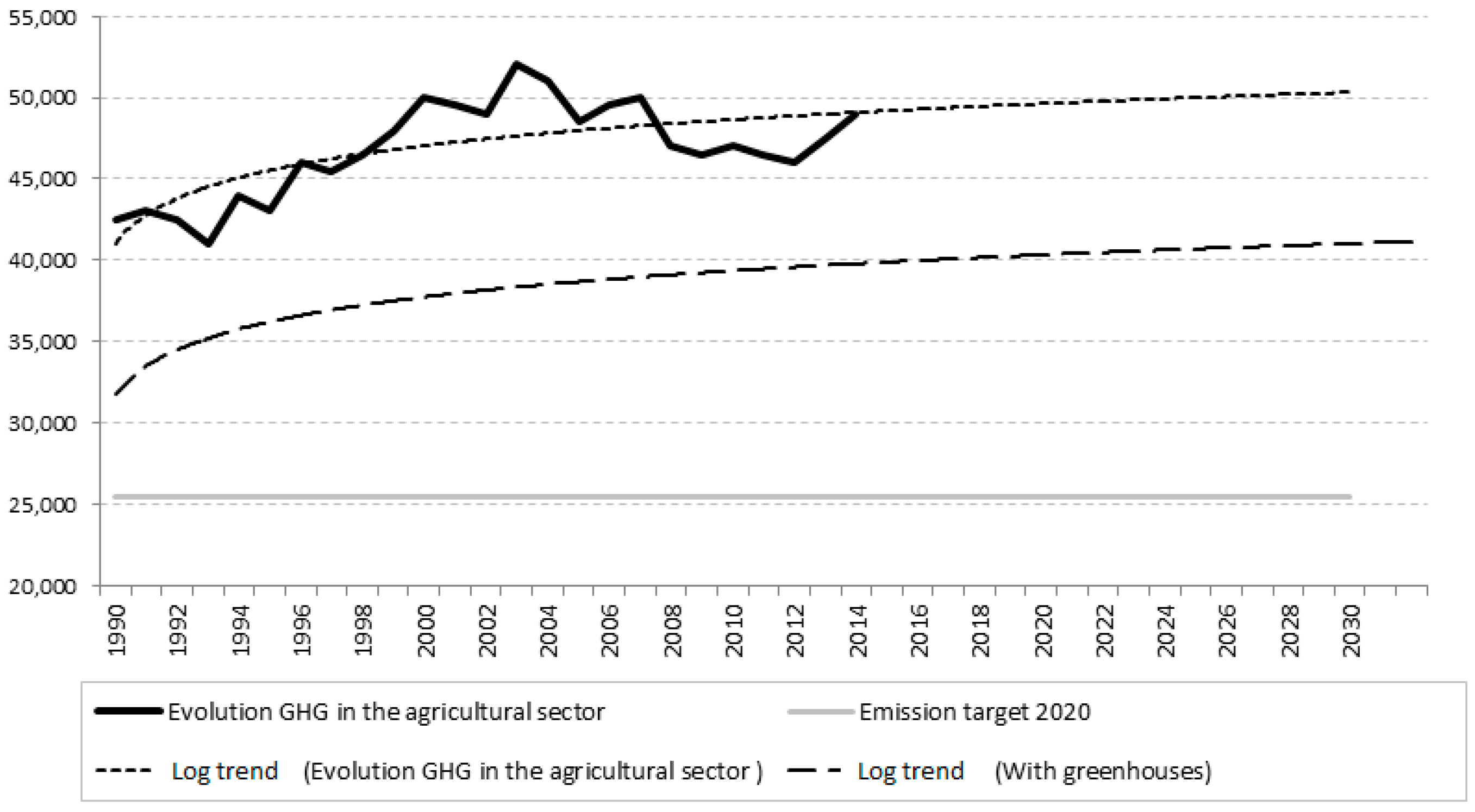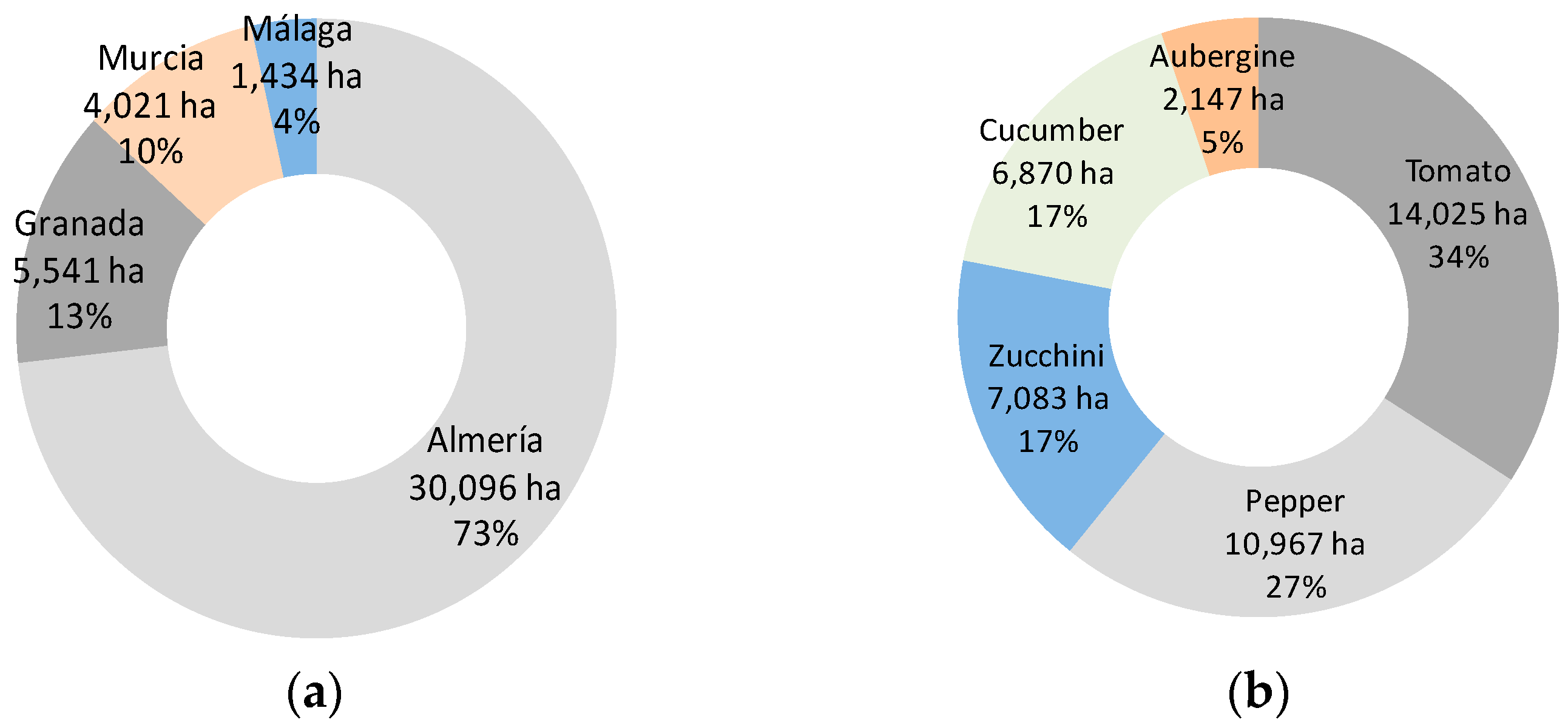3.2.1. Implications in Spanish Energy Policy
Considering the total area of the greenhouse roofs currently existing in southeast Spain, if the potential maximum PV energy production were actually achieved, it would considerably reduce the gap that separates Spain from the objectives set out in the 2030 Energy Strategy [
15,
63].
As expounded above, the objective is to achieve a 40% reduction in greenhouse gas emissions by the year 2030 for the entire EU, with respect to levels registered in 1990. They also aim to ensure a minimum of 27% of energy consumption comes from renewable sources, as well as a series of other goals. At the same time, the 2030 Energy Strategy urgently emphasizes that it is crucial to mobilize all means necessary to achieve the goal of reducing greenhouse gases by 10% (with respect to values from 2005). If this were not achieved, it would have to be fulfilled prior to 2020, specifically by Spain, Portugal and the Baltic State, which are the Member States that have not achieved a minimum level of integration in the internal energy market. In fact, Spain has made a commitment to ensuring that at least 20% of total energy consumption comes from renewable sources by the year 2020.
If we consider, for example, that 10% of the 41,092 ha of greenhouses existing in southeast Spain were to be covered by photovoltaic modules, the potential maximum energy production generated, using current technology, would be 8507 GWh/year (
Table 4), which equates to 731.47 ktep.
This energy production could substitute that of the local thermal power plant (Carboneras, Almería), which operates on coal combustion and boasts an installed power capacity of 1159 MW and a production of 6000 GWh/year. It would also reduce the output of other similar stations nearby by half.
The total energy consumption in Spain (2014), including consumption for non-energy purposes, was 83,525 ktep, of which 13,294 ktep came from renewable sources [
44]. This means that the ratio of renewables only reaches 15.85%, far from the 20% set as the objective for Spain in 2020 [
63].
Based on the data for renewable energy production out of total energy consumed in Spain between the years 2009 and 2014 [
15,
44], a linear projection of the trend for these years was made to estimate percentages of renewable energy that will be reached between 2015 and 2020. It is first considered that increased energy efficiency will compensate for final energy consumption during the period 2015–2020, which will cause a theoretical stabilization of final energy consumption, with figures similar to those of 2014. This projection (
Table 5 and
Figure 5) reveals increases in renewable energy which are inferior to those necessary to meet the objective (20%).
However, the
Figure 6 would be altered by incorporating greenhouse-mounted PV energy production to substitute thermal power plants. Some 731.47 ktep (0.9% of the total energy consumption in Spain, 83,525 ktep) would be added to the total output of renewable. Consequently, the mere adoption of this measure would narrow the gap between the 2020 objective by more than a fourth with respect to 2014 (
Figure 6), considerably helping to meet this officially established goal (20%).
In addition to this support, the promotion of PV technology in greenhouses would produce a positive environmental effect by reducing GHG emissions in the atmosphere, which also constitutes an objective to be achieved in the 2030 Strategy. The substitution of thermal power plants which use coal combustion with energy produced on the greenhouses located in the same area of influence would represent a reduction of slightly less than 10 million tons of CO2Eq each year.
The aforementioned value (
Table 6) refers to the real GHG emissions produced during energy production. However, for the purposes of making comparisons with other scientific studies, it is standard procedure to also determine the carbon footprint (CFOE) produced, which considers the amount of GHG emissions, quantified in CO
2Eq/kWh throughout an entire lifespan. In the particular case of photovoltaic systems, it is necessary to take into account many factors, from the mining of raw materials to the manufacture of components, for example, the modules and structures, battery acid, connection cables, charge inverters and controllers, shipping, maintenance and, finally, recycling. The CFOE value varies according to the installed power capacity on the greenhouses [
64]. If we consider a greenhouse of average dimensions (1.8 ha) with an installation of 260 kWp, the carbon footprint would register somewhere between 0.4 and 0.6 kgCO
2Eq/kWh. By extrapolating these data to the potential energy production in southeast Spain, and using an average value of 0.5 KgCO
2Eq/kWh, we obtain a carbon footprint value of 4.76 million tons of CO
2Eq.
Nevertheless, assuming that Spain fulfills its commitments for 2030 and its intermediate stage by 2020, a standardized value for all EU countries of 0.0 tCO2/MWh GHG emissions will be utilized for photovoltaics. This correlates to a reduction of 9.3 million tons of CO2Eq annually, which would bring figures closer to Spain’s official objective. More specifically, the commitment of the European Union as a whole consists of reducing greenhouse gases by 40% by the year 2030, using data from 1990 as reference. This emissions reduction is calculated for each of the member states, which, at the same time, carry out plans corresponding to specific economic sectors to decrease emissions.
In the specific case of the agricultural and livestock sector in Spain, the emissions trend is rather discouraging. By observing the data registered from 1990 to 2014 [
65], it is seen that numbers had continually been on the rise, increasing from 42.5 to 49 MtCO
2Eq (
Figure 7) when the objective was actually to lower this number to 25.5 MtCO
2Eq [
65]. Based on the data for GHG emissions in the agricultural sector from 1990 to 2014, a logarithmic projection of the trend was made to estimate the levels which will be reached in the year 2030 (
Figure 7). The value obtained was nearly 50 MtCO
2Eq, which represents a difference that is 24 MtCO
2Eq greater than the official objective.
In this way, the contribution of photovoltaic production on greenhouses towards the fulfillment of objectives in the agricultural sector could be pivotal as it could reduce emissions by 9.3 MtCO
2Eq, decreasing the difference cited above by 40% (
Figure 7). For this reason, the adoption of measures aimed at implementing this technology on greenhouses would significantly contribute towards meeting the commitments to the 2030 Strategy.
3.2.2. Implications in Regional Socioeconomic Development
Contribution forecasts for PV energy, in terms of production and consumption, were conducted in 2011 by the Institute for Energy Diversification and Saving [
52]. This analysis revealed that if photovoltaic growth had continued in the last decade (
Figure 8), the GDP would have increased by approximately 2% for Spain as a whole by the year 2020, correlating to an increase in direct income of 3784.3 million euros. However, this growth trend and forecasts were severely hindered by the new energy policies referred to earlier.
While making forecasts in these fields is complicated, especially when there are major changes on a macroeconomic scale (as described in the case of Spain), various studies corroborate the positive effect of renewable energies development on specific socioeconomic variables. In one of these studies, Apergis and Payne analyzed 20 countries in the OECD (Organisation for Economic Co-operation and Development) during 1985–2005 and discovered a positive relationship between consumption of renewables and GDP growth [
66]. More specifically they found that a 1% increase in consumption translated to an increase of 0.76% in national GDP. Similarly, Sadorsky also obtained a positive relationship between consumption and income per capita in a study of 18 developing economies [
67]. Furthermore, a study of G7 countries by Tugcu revealed a causal relationship between renewable and economic growth [
68]. However, other studies found no conclusive results [
69], particularly in the case of Spain, although the aforementioned study ended in 2004, which is why the IDAE (Instituto para la diversificación y ahorro de la energía) utilized data from 2005 onward [
52]. By using the 2005–2010 trend impacts, this study elaborated forecasts for 2015 and 2020, which were then extrapolated to 2030 [
53].
Utilizing these references for the Spanish case, while bearing in mind the current context of new legislation, a forecast is made for the impact of PV electricity generated on greenhouses in the southeast of the country (
Table 7). In this way, the forecasts by IDAE are based on an installation scenario featuring a new minimum power of approximately 1000 MW annually [
52], reaching 2020 with an installed power capacity of 8367 MW (14,316 GWh generated). However, with the actual political framework during that time, the new installed power from 2010 to 2015 was 1258 MW (
Figure 2), far from the prediction mentioned above. On the other hand, when we consider installation of the proposed systems on greenhouses, we observe that the power capacity that can be installed over the next five years is 5917 MW (144 kWp/hectare × 41,092 hectares). This would move Spain closer to 85.76% of the scenario envisioned by some papers for the year 2020 [
52,
53].
PV energy represents 27.9% of employment for all renewables and is one of the types that contribute most to R&D (1.9% of GDP) [
70]. In this regard, these figures position the energy sector near the EU28 average [
15]. Although Spain’s energy sector represents a higher percentage of its GDP than the rest of the EU28, this same sector is still far behind the EU28 average in terms of employment and R&D spending [
68].
Other specific effects must also be considered in terms of social and national impact [
53]. On one hand, several studies qualify job creation in renewable energies as stable and high quality employment: more than 80% of job positions have indefinite contracts, which require either high qualifications (31% higher education) or medium qualifications (24% official studies); the average salary is 52% higher than in the rest of the economy and superior to the average in industrial sectors [
52,
70]. Furthermore, a positive impact is also observed with regard to the employment of young people [
71].
In general, this energy constitutes a way of complementing income generation, not only for its impact on the socioeconomic variables indicated, but also through energy savings, both nationally and regionally. However, it is precisely this regional impact which would achieve the greatest effect in terms of support and consolidation of an “agrifood-energy” sector, with direct repercussions on the industrial and secondary services linked to this sector [
72]. As indicated earlier, this impact would create a vast distribution of income, with very low distribution costs given the proximity of key consumers.
3.2.3. Economic Impact on Southeast Spain Greenhouse Sector
In this line, estimation is carried out below of the consequences of generalized PV energy usage for the whole of the horticultural farming in the southeast Spain that represents 95% of Spanish horticultural crops in greenhouses. This will be calculated in terms of monetary energy savings, while applying only a minimum amount to supply self-consumption of 1.09%, and taking into account the main greenhouse crops (long cycle crops are: tomato, pepper, cucumber, eggplant and zucchini).
Figure 9 shows how the province of Almería represents more than 73% of greenhouse area in southeast Spain, and tomato and pepper alone constitute 61% of the total. Considering standard farm size, production and average prices of energy consumption per crop, it is possible to calculate the savings that would be achieved by implementing this technology throughout the entire sector.
Figure 10 displays the savings for each crop in relative terms (according to base case). The savings over annual profit, depending on the type of crop, oscillate between 6% for pepper (9.8% with aid) and 11.9% for eggplant (20.3% if subsidies exist). The absolute savings vary between €3470 in tomato without subsidies (€4940 if we consider that subsidies exist) and €2320 in cucumber (€3740 with subsidies). It must be noted that the implementation of PV energy would be of special interest given the potential profit growth for growers specializing in tomato, eggplant and zucchini.
Taking into account the entire production area (
Figure 11), the total savings would be €62 million without any aid. This represents 7.8% of all sector profits (which reach €795 million). The crop that most contributes to the sector is tomato (€27 million) due to a larger farming surface area (14,025 hectares). The products which follow in terms of importance are pepper, zucchini and cucumber, the latter two with similar figures (hovering around €15 million in savings). If subsidies are taken into consideration, this would imply savings that would reach €96 million (12.1% of all sector profits).
Figure 12 shows the sector’s savings in euros as a result of the increased area of greenhouses with PV panel installations (18,000 m
2). As can be seen, by merely rising from 1.09% of the area to 3.7%, savings would increase by 240% (considering the presence of aid), reaching €299 million, that is, 38% all profits combined. In general, the implementation of this technology would absolutely ensure profitability in a highly variable sector, as is agriculture.
